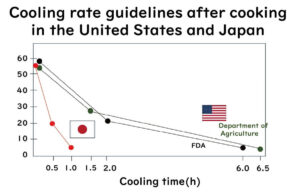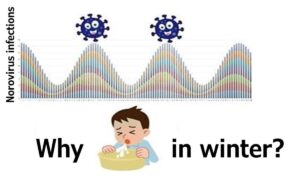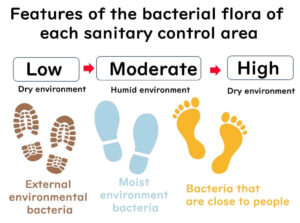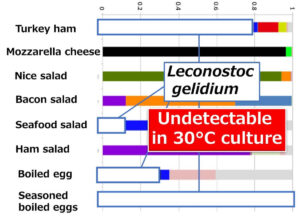Vibrio cholerae attaches to zooplankton using the same factors that infect humans
Vibrio cholerae can attach to the surfaces of zooplankton such as larval shellfish and shrimp. These environments offer two main benefits to Vibrio cholerae: an abundance of nutrients and protection from various environmental stresses. In this article, we introduce a study suggesting that the genes responsible for cholera toxin, which typically causes human infection, might have originally evolved to help the bacteria survive in natural ecosystems.
Bacillus cereus Hazards in Cooling Cooked Rice: Exact Temperature and Time to Prevent Food Poisoning
In this article, we will delve into crucial research findings by USDA researchers on the relationship between the cooling rate of cooked rice and the growth of Bacillus cereus, and explore preventive measures against food poisoning caused by Bacillus cereus in detail.
Why Norovirus Peaks in Winter — The Hidden Role of Absolute Humidity
In temperate regions, bacterial food poisoning incidents typically peak from early summer to autumn. This surge is due to the favourable warm temperatures that facilitate the growth of pathogenic bacteria in food. Conversely, norovirus infections are more prevalent in winter. Why is this? Is it because we eat oysters in winter? Does the virus become more potent in the cold? Until recently, the scientific data was insufficient to provide clear answers. However, the study we are discussing in this article offers a potential explanation.
Analysis of the Bacterial Flora of Milk Powder Plants by 16S rRNA Amplicon Sequencing
Contamination of powdered milk by Cronobacter sakazakii and Salmonella poses severe health risks to infants. Preventing the introduction of Cronobacter sakazakii before the packaging stage in powdered milk factories is crucial. To achieve this, the analysis of bacterial flora in the factory environment is of significant importance. This article introduces a study that monitored the microbial communities in two powdered milk factories in Ireland over two years using 16S rRNA amplicon sequencing technology. This research is the first to investigate the bacterial flora in the environment of powdered milk factories using 16S rRNA amplicon sequencing analysis.
What is the Purpose of Microbial Testing of Food Products at the Time of Shipment in Food Manufacturing Plants? How Reliable is it?
Ensuring that food products meet the microbial standards set for each type of food is, of course, essential. However, in the case of voluntary testing, the effectiveness of microbial testing of products at the time of shipment varies. Some foods benefit significantly from such tests, while for others, the efficacy is minimal. So, which foods benefit from microbial testing at shipment, and which do not? This article introduces a scientific paper that investigates this issue. The author is Dr. Zwietering, Chair of the International Commission on Microbiological Specifications for Foods (ICMSF) as of May 2022.
Controlling Listeria monocytogenes in Ready-to-Eat Foods with Nisin and Organic Acids
Listeria monocytogenes is a notorious risk in food processing facilities, particularly known for forming biofilms that make it hard to eliminate entirely from ready-to-eat (RTE) products. A promising solution gaining attention in the US is the combined use of nisin and organic acids during distribution. This article delves into how this method helps control Listeria monocytogenes in RTE foods, enhancing their safety.
Peracetic Acid Preparations as a Bactericide for Campylobacter and Salmonella from Broilers
In this article, I'll be discussing a fascinating paper that examines the effectiveness of peracetic acid as a disinfectant in poultry processing plants, particularly in the chilling process of broilers. This study was conducted by Dr. Nagel from Auburn University in the United States.
Summer holiday
Due to summer holiday, the blog will not be updated from 7 July to 11 August. Updates will resume on 18 August.
Chilled Food Spoilage and Psychrotrophic Lactic Acid Bacteria
This article delves into the spoilage of chilled foods and the role of psychrotrophic bacteria, specifically lactic acid bacteria. We explore findings revealed through 16S rRNA amplicon sequencing analysis, which identifies bacteria undetectable at a culture temperature of 30°C. In a previous article, we discussed a study by Dr. Pokasos and his team from Ghent University, Belgium. Their research demonstrated that culturing at 30°C fails to detect psychrotrophic bacteria, leading to an underestimation of microbial counts. This article serves as a continuation of that discussion.
How Effectively Does the ISO-Standard Aerobic Plate Count (30°C, 72 Hours) Test Measure Cold-Tolerant Bacteria?
The measurement of aerobic plate counts is divided into two methods: the AOAC method used in the United States (35°C for 48 hours) and the ISO method used in the EU (30°C for 72 hours). The ISO method uses a lower incubation temperature for a longer duration compared to the US method. This approach is intended to detect cold-tolerant bacteria more effectively, as discussed in a previous article. However, even the ISO method is insufficient for detecting all cold-tolerant microorganisms. How effectively does the ISO method for aerobic plate count testing detect cold-tolerant bacteria and spoilage lactic acid bacteria?








